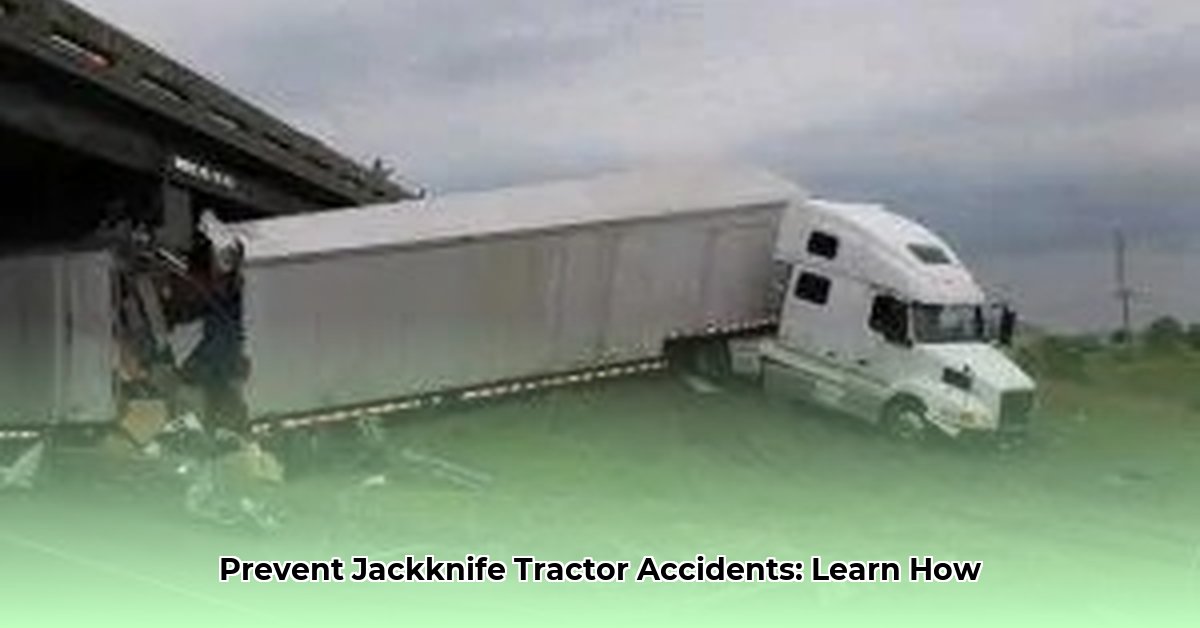
Understanding Tractor-Trailer Jackknifing and Rollovers
Tractor-trailer jackknifing (where the cab and trailer form a sharp angle) and rollovers are serious safety concerns, resulting in significant property damage, injuries, and fatalities. While often attributed to driver error, these accidents are complex events stemming from a confluence of factors. Understanding these contributing factors is the first step toward effective prevention. For more information on reliable tractor brands, check out this resource.
Key Contributing Factors:
- Driver Error: Speeding, especially on curves or in adverse weather; sudden braking; driver fatigue; distraction (e.g., cell phone use); inadequate training.
- Vehicle Limitations: Overloaded trailers; long wheelbases; worn tires; faulty brakes.
- Environmental Conditions: Icy roads; strong crosswinds; heavy rain.
Preventing Jackknife Accidents: A Multi-pronged Approach
Preventing jackknifing and rollovers requires a comprehensive strategy involving multiple stakeholders. Each group plays a crucial role in enhancing road safety:
1. Trucking Companies: Investing in Safety
Enhanced Driver Training: Implement a rigorous curriculum emphasizing defensive driving, safe braking techniques (especially in adverse conditions), proper load securing, fatigue management, and emergency maneuvers. Incorporate simulator training to provide realistic, safe practice scenarios. Why simulate? Simulation provides experience without risk, improving driver confidence and reaction time.
Rigorous Vehicle Maintenance: Regular vehicle inspections are critical, focusing on braking systems (including ABS), tire condition, and load-sensing regulators. Proactive maintenance minimizes mechanical failures contributing to accidents. What percentage of accidents are linked to poor maintenance? A significant portion of accidents are directly attributed to preventable mechanical failures.
Embracing Advanced Technology: Integrate Advanced Driver-Assistance Systems (ADAS) like lane departure warnings, forward collision alerts, and automatic emergency braking. These technologies provide drivers with crucial real-time alerts and assistance. Have you considered the potential of ADAS in reducing accident rates? Studies suggest that ADAS can significantly decrease accident frequency.
2. Government Agencies: Shaping Safer Roads
Targeted Public Awareness Campaigns: Launch impactful campaigns using diverse media (TV, radio, social media) to educate the public about the dangers of jackknifing and rollovers. Use clear, concise messaging that highlights the significance of these risks and focuses on proactive safety measures. How can public awareness campaigns improve situational awareness? By increasing awareness, we can improve driver behavior and promote proactive safety measures.
Strengthened Regulations and Enforcement: Review and strengthen regulations concerning driver hours of service, load securing, and vehicle maintenance. Ensure rigorous enforcement of these regulations with significant penalties for violations. What is the impact of stricter regulations? Implementing and rigorously enforcing stricter regulations reduces accidents by encouraging compliance.
Investing in Research and Development: Fund research into advanced safety technologies such as predictive systems, enhanced ADAS, and improved tire technology suitable for challenging conditions. Are there ongoing studies regarding the effects of improved tire technology? Yes, many organizations are actively researching the impact of updated tire technology on safety.
3. Driver Training Schools: Equipping Drivers with Essential Skills
Curriculum Enhancement: Update training curricula to include detailed sections on vehicle dynamics, emergency maneuvers, appropriate braking techniques in varied conditions, and effective accident avoidance strategies.
Simulator-Based Training: Make simulator training a core component of the curriculum. Simulators allow trainees to practice handling challenging situations in a safe and controlled environment, building both skills and confidence. How effective is simulator training? Real-world findings demonstrate that simulator-based training is highly effective in improving driver performance.
4. Technology Developers: Innovating for Enhanced Safety
Improving Existing Technologies: Focus on developing more reliable, affordable, and robust ABS and load-sensing systems. Wider adoption of these critical safety features is vital.
Developing Advanced ADAS: Invest in next-generation ADAS specifically designed for heavy vehicles, including systems capable of proactively identifying and mitigating potential jackknife situations through automatic speed and braking adjustments based on real-time conditions. What innovations are currently being explored in ADAS technology? Current research focuses on more sophisticated predictive models and automated response systems.
Risk Assessment Matrix
The likelihood and severity of jackknifing accidents depend on the interplay of various factors. A risk assessment matrix helps prioritize mitigation efforts:
| Factor | Likelihood of Failure | Severity of Impact | Overall Risk | Mitigation Strategy |
|---|---|---|---|---|
| Inadequate Driver Training | High | High | Very High | Comprehensive training, regular refresher courses, simulator training |
| Faulty Braking Systems | Moderate | High | High | Regular maintenance, prompt repairs, advanced braking systems |
| Poor Load Securing | Moderate | High | High | Stricter regulations, improved training, load sensors, securement methods |
| Adverse Weather Conditions | Moderate | Moderate | Moderate | Driver awareness, route planning, speed reduction, weather monitoring |
Regulatory Implications: A Call for Action
While some regulations exist, stricter enforcement and a push for adopting new technologies are crucial. Mandating essential ADAS in newer vehicles and implementing stronger penalties for safety violations are significant steps towards enhancing road safety. This multi-faceted approach, combining driver training, advanced technologies, and robust regulations, is essential to significantly reducing jackknife and rollover accidents.